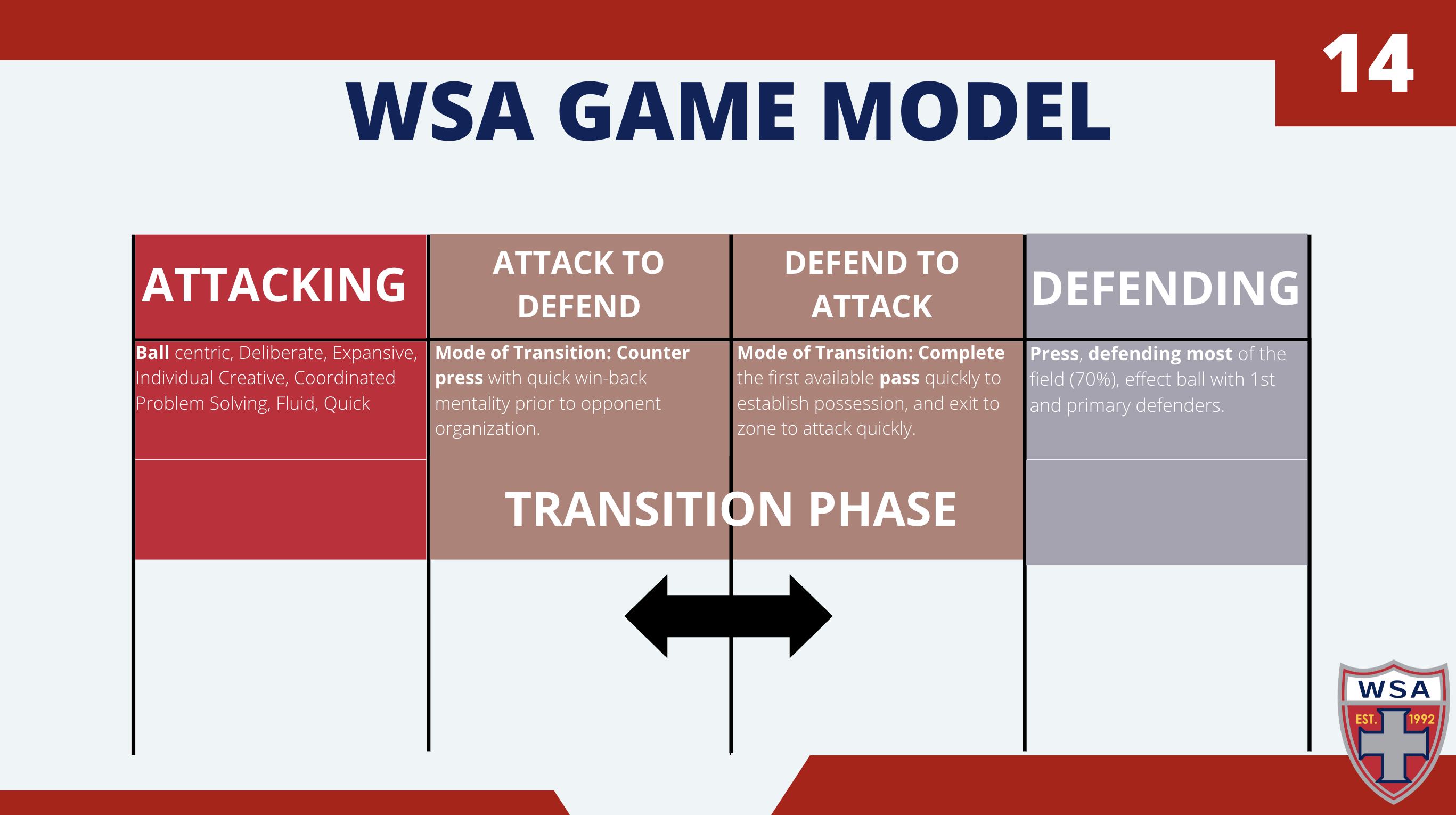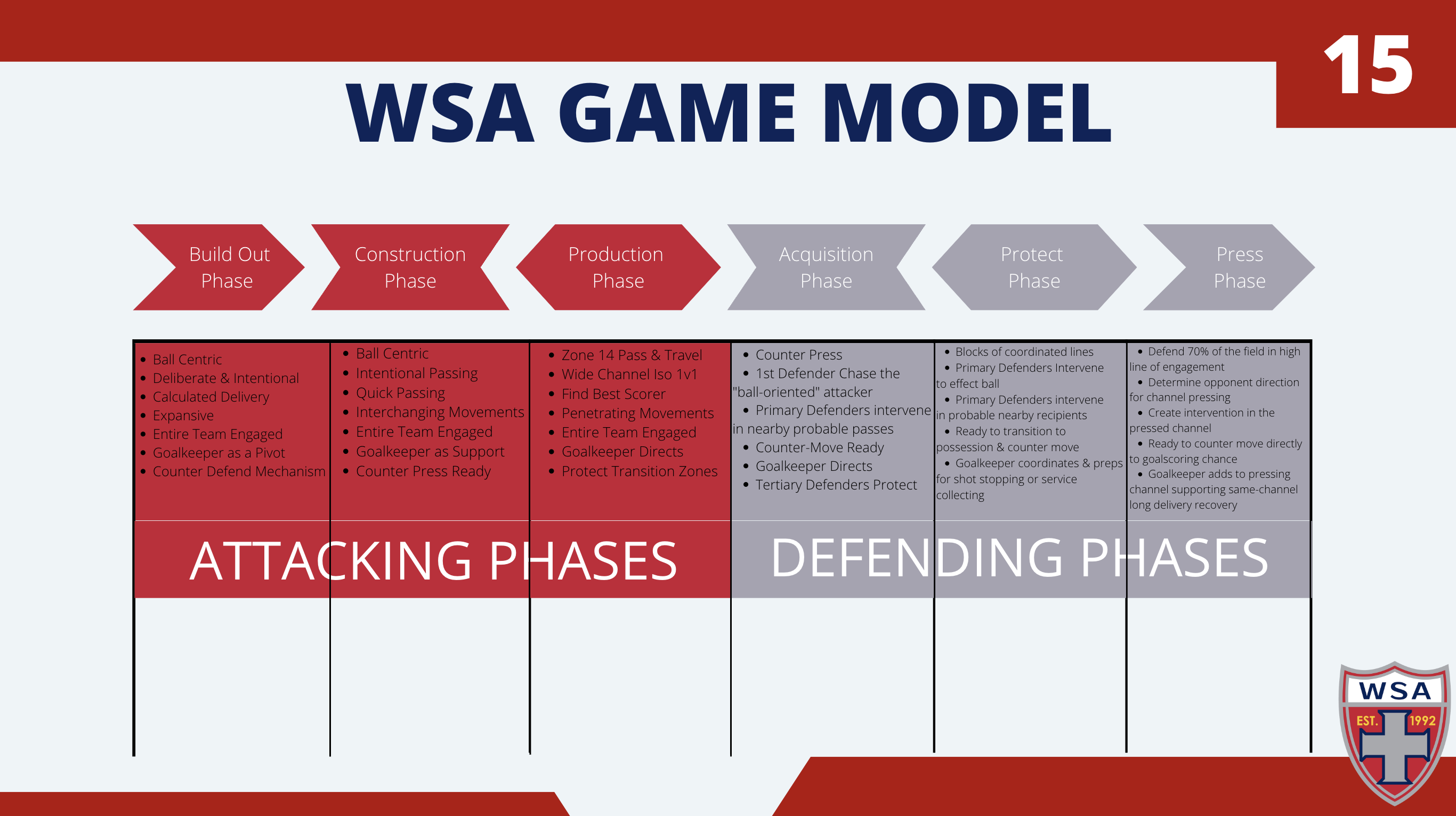SOCCER CORNER MUSINGS 1
"Want to rise? Descend first. Want to build a tower that will pierce the clouds? Lay first the foundation." - St. Augustine
Thank you for promoting and participating in the first club-wide session. I appreciate your cooperation in doing something different.
Provide Feedback Here
Here is a quick follow up:
Attack to Defend TRANSITION (hosted June 5-6 Club-Wide)
From The WSA Way Game Model
Age Group Session #1:
The WSA Way Game Model: Counter Press
The Session that was proposed w/ video tutorials - click here.
Counter Press: quick win-back mentality prior to opponent organization.
o The Defending Phases: Acquisition - the focus topic of the session
o Counter Press
o 1st Defender chase the “ball-oriented” attacker
o Primary Defenders intervene nearby probable passes
o Counter Move Ready
o Goalkeeper Directs
o Tertiary Defenders Protect
o The Defending Phases: Protect (coordinate to affect ball & block opponent)
o The Defending Phases: Press (defend 70% of the field, dictate & recover)
FROM ROGER:
The above is information directly from The WSA Way, Club-Wide Game Model. See pictograph attached.

As a reminder of a few critical pieces of info regarding the recent session on A-to-D transition:
1. The session was designed to meet demands for the lowest level of our u11 program to the highest level of our u19 program. This compromises the session in many areas. THANK YOU to all our lead trainers! You helped modify the session for the level and age.
2. It was TOPICAL session. There was a specific topic. It was NOT a “Functional”, “Tactical”, “Conceptual”, “Technical” session. It was meant to focus on ONE TOPIC. That topic: “The WSA Way to Transition from Attacking to Defending”. Your Directors of Coaching identified a SPECIFIC WAY for this to happen within the WSA Way over the past year. This is IMPORTANT. There are various WAYS to transition from A to D, and they each have consequences, require intentionality in certain areas, and must fit into a broader game model.
3. BALL RECOVERY is DIFFERENT THAN SPACE RECOVERY. I was able to converse with several of you, who pointed out various ways to teach SPACE RECOVERY. These were awesome! The session TOPIC was NOT on “space recovery”. The session was focused on “Ball Recovery via Early Intervention”. "Space recovery" (i.e. after a press is broken, when an opponent counters, or inside a game tactic that might intend for your team to "recover" instead of "intervene").
(Note1: There is ball recovery in other phases of play, this topic is specifically related to “moment of transition ball recovery”).
(Note2: There are game moments that dictate defending principles, i.e. an opponent errant pass, or bad touch, or a certain territory that you have determined your players to intervene more aggressively).
(Note3: the dynamics of the game should NOT ever deter you from coaching and leading certain principles, this is HOW your team - and your club - create IDENTITY, UNITY and COMMUNITY).
4. WHAT IS NEXT - AFTER ALL WE MIGHT FAIL AT THE COUNTER PRESS: Ideally every time an opponent obtains possession from WSAs 150+ teams, over next year’s 4,000 matches we play, which is likely to occur on 1.2 Million occasions, WSA would win the ball back immediately! But… just in case sometimes this method does not work…. there would be a next phase of defending. See above “Protect” and in certain times of the game even another phase of defending “Press”. These are all uniquely different phases, with uniquely different intentions, and their own set of functions. Each of these phases also becomes territorial (box defending, territorial pressing, etc).

ROGER'S SUMMARY:
The CLUB-WIDE A-to-D session was meant to introduce or reinforce a concept to all of the 10-19 year olds in our program: that upon a TURNOVER of the ball, the response by the WSA WAY is IMMEDIATE to INTERVENE. Why? We want the ball back. Secondarily, we want to intervene early to prevent the opponent from organizing. And from a teaching standpoint – we believe this syncs w/ our desired character outcomes.
To be clear this is counter intuitive to dropping, blocking, recovering space, coordinating lines, communicating press-cover-balance, etc…. It is also counter intuitive to slow response, quitting, lack of effort, negative body language, etc… The intuition we are trying to drive upon a WSA turnover, is a habit that is often opposed by the following player traits to a turnover:
o Head drop
o Overall negative body or verbal language
o Lost focus on the transition
o Recovering Space in the moment instead of intervening
o Lack of continued Effort
o Quitting
o Taking time to blame others for the turnover
o Conceding possession back to the opponent
o Taking a Moment to Understand what happened
WHY THE WSA WAY on A-to-D transition?
This response to a turnover fits our game model and all of our desired character and style of play outcomes:
- Fail Forward
- Takes Risks w/o Fear bc we have a recovery system
- Do not quit
- Retain Champion’s Posture (shoulders back, chin up, eyes forward)
- Ball Centric Game Model – we want the ball
- Effort & Persistent from our attitude and spirit
WHAT ARE THE RISKS TO THIS GAME MODEL TRAIT?
The risks are probably obvious. If you counter press:
- You may fail and the immediate counter pressers are eliminated from your defending lines
- Requires more energy and fitness – we might be deficient
- Requires speed, quickness that are physical – we might be deficient
- Requires mental acuity, ability to forecast – we might be deficient
- Requires TRAINING HABITS – the action is habitual and non instinctual to failure
- Requires persistence in training by the coach – creating habits must be habitual by the leader
- Requires patient response by coach as players learn
- Requires willingness by coach for players to to take risks, fail, and modify/learn
- Your team is too expanded to effectively counter-press (may require game model modification)
WHAT ARE THE REWARDS TO THIS GAME MODEL TRAIT?
- Your team controls tempo
- Your team controls where and how the opponent attacks
- Your team controls possession – THE BALL
- YOUR players GROW IN CHARACTER traits that are related to ENERGY & EFFORT
- You get to teach Risk:Reward Ratios & Fail Forward Models
- Your team plays like Barca of the 2000’s (the 5-second rule).
WHAT AGES DOES THIS MATTER:
10 years and up.
This session is teaching a HABIT. Do you believe it is important to teach a 10-year old proper nutrition and hydration, knowing that metabolically the Good Lord designed the 10-year old’s biology to counter act some early in life bad decisions? If so you likely believe this is important b/c you are teaching and creating a groundwork of a lifelong habit.
WHAT AGE TEAMS INTRODUCE THIS AS A TACTIC:
This is widely debated. An easy answer is it depends on team level. 13U and up would seem to make sense. However, even if not introduced as a team at U11 & U12, the "TOPIC", the "CONCEPT" can and should be trained as a WSA Way Game Model Trait. Form the habit. Lay the foundation. At worst, players learn EFFORT, ENERGY, BODY LANGUAGE, FAIL FORWARD CONCEPTS - and this is INVALUABLE.
"Want to rise? Descend first. Want to build a tower that will pierce the clouds? Lay first the foundation." - St. Augustine
WHERE CAN I SEE THIS IN ACTION?
The Barca 6-second rule
Counter pressing in every sport is a HABIT. Watch the Miami Heat in the NBA Finals. They “counter press” on opponent Defensive Rebounds by immediately blocking the on-ball player’s outlet passes. Early intervention. Doing this, instead of turning and running back, or spending time sulking about losing the ball, is a HABIT that is likely required to be taught, expresses itself in the right culture, under consistent and persistent leadership, driven by the right character and personality traits.
We engage in this ambitious effort b/c we believe we have the players with capacity, and coaches, you, who can lead it!

NEXT CLUB-WIDE SESSION: Transition Defending to Attacking. “The First Pass Principle”.
Provide Feedback FROM SESSION 1 Here


